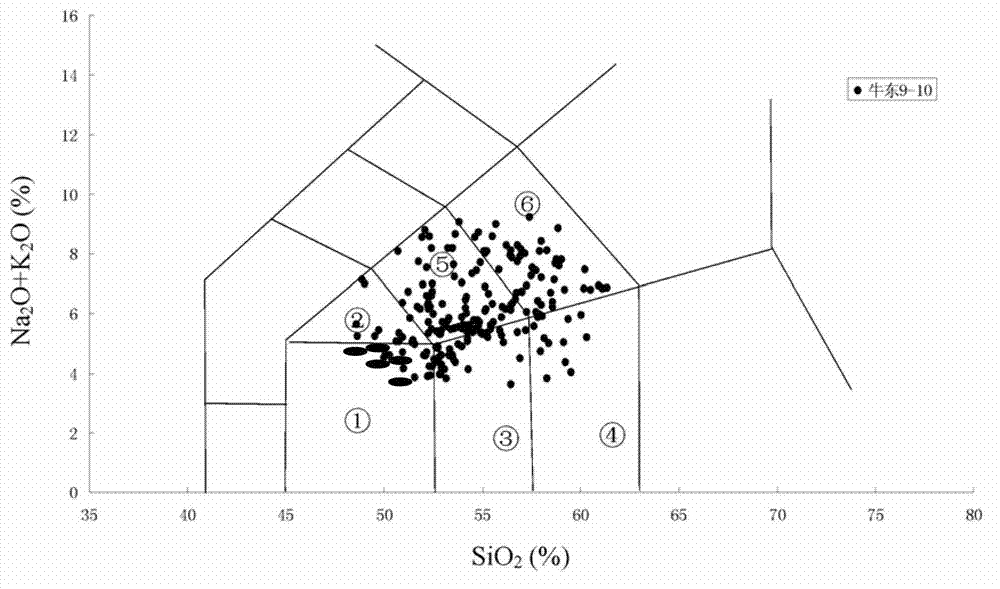Identification method of basic extrusive rock-basalt
An identification method and technology of extrusive rocks, applied in measuring devices, material analysis through optical means, instruments, etc., can solve the problems of time-consuming, laborious, difficult to distinguish, expensive, etc., and achieve the effect of simple operation methods
- Summary
- Abstract
- Description
- Claims
- Application Information
AI Technical Summary
Problems solved by technology
Method used
Image
Examples
Embodiment 1
[0027] This example provides a method for identification of basic extrusive rock-basalt, using the Carboniferous (C2b) 1505.33-meter rock sample from Well Niudong 9 in Santanghu Oilfield as the sample crystal, and adopting the Petroleum and Natural Gas Industry Standard SY of the People's Republic of China / T5913-2004 "Rock Sectioning Method" to prepare rock thin slices of igneous rock samples, and use the following steps to determine the type of the rock samples. The specific steps include:
[0028] 1. Select plagioclase with weak particle surface alteration in the above-mentioned rock slices and place it in the center of the field of view of the crossed polarizing microscope, find the twin crystal limit of the plagioclase, and make the twin crystal of the plagioclase The limit is parallel to the longitudinal wire of the reticle of the eyepiece, and the scale of the stage is recorded as a=333 degrees;
[0029] 2. Turn the stage to the left to make a group of plagioclase monom...
Embodiment 2
[0037] This example provides a method for identification of basic extrusive rocks-basalts, using the Carboniferous (C2b) 1505.40-meter rock sample from Well Niudong 9 in Santanghu Oilfield as the sample crystal, and adopting the Petroleum and Natural Gas Industry Standard SY of the People's Republic of China / T5913-2004 "Rock Sectioning Method" to prepare rock thin slices of igneous rock samples, and use the following steps to determine the type of the rock samples. The specific steps include:
[0038] 1. Select plagioclase with weak particle surface alteration in the above-mentioned rock slices and place it in the center of the field of view of the crossed polarizing microscope, find the twin crystal limit of the plagioclase, and make the twin crystal of the plagioclase The limit is parallel to the longitudinal wire of the reticle of the eyepiece, and the scale of the stage is recorded as a=332 degrees;
[0039] 2. Turn the stage to the left to make a group of plagioclase mon...
Embodiment 3
[0047] This example provides a method for identification of basic extrusive rock-basalt, using the Carboniferous (C2b) 1515.39-meter rock sample from Well Niudong 9 in Santanghu Oilfield as the sample crystal, and adopting the Petroleum and Natural Gas Industry Standard SY of the People's Republic of China / T5913-2004 "Rock Sectioning Method" to prepare rock thin slices of igneous rock samples, and use the following steps to determine the type of the rock samples. The specific steps include:
[0048] 1. Select plagioclase with weak particle surface alteration in the above-mentioned rock slices and place it in the center of the field of view of the crossed polarizing microscope, find the twin crystal limit of the plagioclase, and make the twin crystal of the plagioclase The limit is parallel to the longitudinal wire of the reticle of the eyepiece, and the scale of the stage is recorded as a=111 degrees;
[0049] 2. Turn the stage to the left to make a group of plagioclase monom...
PUM
 Login to View More
Login to View More Abstract
Description
Claims
Application Information
 Login to View More
Login to View More - R&D
- Intellectual Property
- Life Sciences
- Materials
- Tech Scout
- Unparalleled Data Quality
- Higher Quality Content
- 60% Fewer Hallucinations
Browse by: Latest US Patents, China's latest patents, Technical Efficacy Thesaurus, Application Domain, Technology Topic, Popular Technical Reports.
© 2025 PatSnap. All rights reserved.Legal|Privacy policy|Modern Slavery Act Transparency Statement|Sitemap|About US| Contact US: help@patsnap.com

